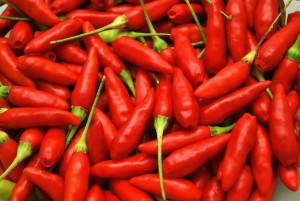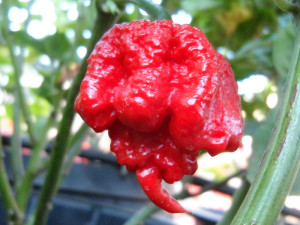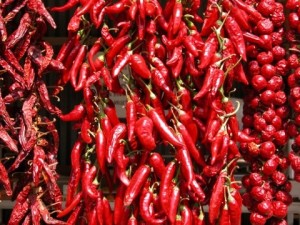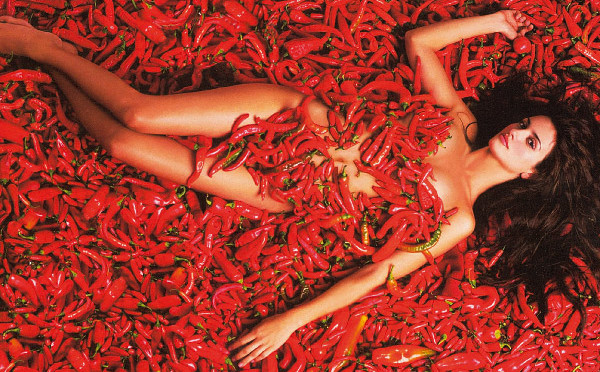Hot peppers and ranking of hotness…. To tell you the truth I would have preferred to call this post with a completely different title, I liked it better “Why we eat the chili?” but as usual the choice fell on the keywords that are searched most often on Big G that is the most used in the world famous search engine.

The Peppers and The Rank Of Spiciness
Just a few weeks ago, opening the search page I could not help but notice the new “doodle” Google dedicated to Wilbur Scoville (1865) who is the inventor of the scale still used today for measuring the degree of spiciness of chilies. Wilbur Scoville was born in the US 151 Years ago, He worked in a pharmaceutical company to the production of a new type of balm, when he had the brilliant idea to run a test on the spiciness of chilies. The named test “test organolettico di Scoville” It provided for the dilution of the extract of hot pepper in a water-based and sugar solution. Assisted by a group of tasters,It was diluted with further addition of sugar until it was not considered totally devoid of hotness. Just by using the necessary dilutions and the amount of capsaicin contained in different types of hot peppers, Scoville was able to classify the spiciness.

The Peppers and The Rank Of Spiciness
According Scoville a sweet pepper contains capsaicin, therefore has a zero value, Figure instead at the highest level with the pure capsaicin 16 millions.
To date the highest degree of the scale is occupied by “Carolina Reaper” from the South Carolina got in the greenhouse from a cross between different chilies, with a value of 2 million Scoville. This chili is definitely not edible, the only contact with the skin leaving visible burns.
Other peppers of the right common to give you an idea of the values of this hotness scale do not come to 100.000.
Paprika does not reach even to 900
What we usually consider powerful…The Jalapeno can vary from 3000 to 10.000 and the Cayenne is around 50.000 unit.
The very common and widespread chili Calabrese breed commonly used in Italy for our spaghetti aglio olio and peperoncino or for our pizzas, than just the 15.000 unit.
Today to measure the degree of spiciness of chilies using a different method, a chemical process called liquid chromatography, that allows us to discover the amount of alkaloids such as capsaicin that are contained in different types of hot peppers, It may seem strange, but the modern result is still very similar compared to the Scoville scale.

The Peppers and The Rank Of Spiciness
We finally got to the part that I find most interesting:
Why we eat spicy food?
If you ask someone the feeling that evidence in eating chilli, many will answer that is perfectly comparable to a real pain. The answer is really correct, as spicy food ingested causes to our taste buds a real pain simulation, irritation and burns. In simple words, the nerves send an alarm signal to warn us that our palate stà burning. So because it taste test in eating chili?
For the famous psychologist Paul Rozin the answer is simple and is the same one that also explains why we do the activities they not seem senseless as the bail or jump off a bridge tied to a rubber band.
Men love it enjoy situations in which the body launches warning signs and know that in reality everything is ok.
|
Scoville gradation |
chili Type |
|---|---|
|
15.000.000 – 16.000.000 |
Diidrocapsaicina, capsaicin pure |
|
8.800.000 – 9.100.000 |
Nordiidrocapsaicina |
|
6.000.000 – 8.600.000 |
Omodiidrocapsaicina, Omocapsaicina |
|
2.500.000 – 5.300.000 |
Pepper spray in use to the police |
|
2.000.000 – 2.200.000 |
Carolina Reaper |
|
1.067.286 – 2.000.231 |
Trinidad Scorpion Moruga, Trinidad Scorpion Butch Taylor, Naga Viper, Infinity Chili, Pepper spray in common use |
|
855.000 – 1.041.427 |
Naga Morich, Naga Dorset, Seven Pod (o Seven Pots) |
|
876.000 – 970.000 |
Very Jolokia (also known as Ghost Chili), Naga Jolokia (Hybrid) |
|
350.000 – 855.000 |
Habanero Red Savina, Indian Tezpur |
|
100.000 – 350.000 |
Habanero, Jamaican Hot, Bird’s Eye (also known as “Piripiri”, “pepper”, “African Devil”) |
|
50.000 – 100.000 |
Scotch Bonnet, confluence, Chiltecpin, rocoto, Thai Pepper (also known as Thai Dragon), |
|
30.000 – 50.000 |
Chili pepper, Cayenne, Tabasco, prick |
|
15.000 – 30.000 |
Chile de Arbol, Calabrese, Manzano |
|
5.000 – 15.000 |
Peter Pepper, Serrano, Jalapeño |
|
2.500 – 5.000 |
Mirasol, Chipotle, poblano |
|
1.500 – 2.500 |
Sandia, Jingle Bell, NuMex Big Jim, NuMex Suave |
|
1.000 – 1.500 |
Width, Anaheim, pasilla Bajio, Spanish |
|
100 – 1.000 |
Mexican Bell, Cherry, New Mexico Pepper, Pepper, Paprika |
|
0 – 100 |
Bell pepper, pimento (allspice), sweet paprika |
In professional courses for pizza that we offer habitually in our school of pizza, the chili on pizza and chili combined with the street food is an integral part of the program. If you want to know more visit our page School of pizza.
